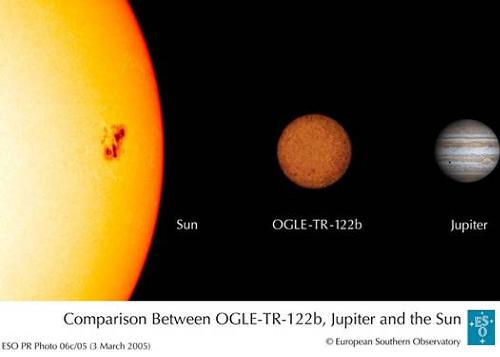Astronomers have discovered a burning core of a star, like our sun, which is only 16% bigger than Jupiter, even though it has 96 times its mass.
Avi Blizovsky

Direct link to this page: https://www.hayadan.org.il/1011146.html
Astronomers have discovered a burning core of a star, like our sun, which is only 16% bigger than Jupiter, even though it has 96 times its mass. The observations were made from the Southern European Observatory - a VLT telescope with a diameter of 8.2 m in the shade.
The astronomers tracked 60 stars known to have a change in brightness due to the passage of another body. The study revealed that 7 of them are low-mass stars orbiting a companion star.
An international team has been able to estimate the radius and mass of the smallest known core burning star.
The observations made in March 2004 with the FLAMES telescope in Tsila are part of a larger program to measure the radial velocity of 60 fading stars discovered in the OGLE survey.
The astronomers found that the change in the brightness of the star OGLE-TR-122 is due to a small companion star that orbits the star in a period of 7.3 days.
This star has a mass 96 times that of Jupiter, but it is only 16% larger than it. This is the first time that direct observation shows that stars with a mass of less than 1/10 the mass of the Sun are of similar size to the giant stars.
In addition, the observations led to the discovery of 7 double stars which include stars with a mass of less than 1/3 of the sun's mass.
OGLE study
When a star passes in front of the parent star, it blocks a certain fraction of light coming from the star. These transitions are of great interest because they allow astronomers to measure in a unique way the mass and radius of the stars. Several studies are carried out on the subject.
One of the programs is the OGLE study which was originally designed to observe the change in brightness of a large number of stars over extended intervals. Over the past few years, the research included a search for periodic declines in brightness caused by the passage of small bodies orbiting the stars. The research team announced 177 candidates for such transitions in a study that included an examination of hundreds of thousands of stars in three southern fields - one towards the center of the galaxy, the second in the Carina array and the third in the Centauri/Mosca array.
The speed and amplitude of the rotation are directly related to the mass of the accompanying star, so it is possible to discriminate between stars and their accompanying stars by examining brightness changes.
The team examined 60 stars from the OGLE program that are candidates for companion stars and measured their radial velocity to an accuracy of about 50 m/s.
Most of the observed stars were found to be double stars, in most cases a small star with a low mass passes in front of a similar star.
Low-mass stars are interesting bodies, also because their physical conditions are similar and have things in common with gaseous superstars like Jupiter in our solar system. Furthermore, determining the size of the small stars provides information on the behavior of matter under extreme conditions. Until recently, very little was known about low-mass stars. Until now, the exact values of the radius of stars with a mass of 1/3 of the solar mass were known only for 4 stars and no star with a mass of less than 1/8 of the solar mass was known at all.
This situation is now changing dramatically when 7 double stars with a mass of less than 1/3 solar mass were discovered in the study.
These new observations almost tripled the amount of low-mass stars for which the radius and mass are known, and moreover one of the above-mentioned stars was discovered to be the smallest known star.
The observations revealed a 1.5% change in brightness every 7 days, 6 hours and 22 minutes. Each decay lasted 188 minutes. This is proof of a low-mass star very close to the hydrogen combustion limit surrounding OGLE-TR-122, this star is named OGLE-TR-122b
The decay in brightness makes it possible to estimate the ratio between the radii of the stars and the orbit makes it possible to estimate the mass of the companion star when the mass of the major star is known.
The findings showed that the companion star weighs 1/11 of the Sun's mass and has a diameter of 1/8 of the Sun's diameter, and although it has a mass of 96 times the mass of Jupiter, it is only 16% larger than the giant star. The density of the star is 50 times that of the sun.
Like any star, OGLE-TR-122b produces energy in internal nuclear reactions, however due to its low mass the energy production is very low especially compared to a star similar to the Sun.
Comments:
Failed stars are objects with a mass 75 times that of Jupiter.
The radius of a star the size of Jupiter is 1/100 of the radius of a sun-like star, because it covers 1/100 of its surface and therefore blocks 1% of the light.
https://www.hayadan.org.il/BuildaGate4/general2/data_card.php?Cat=~~~1011146~~~97&SiteName=hayadan
